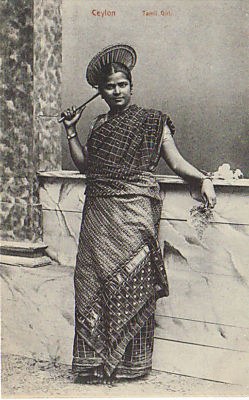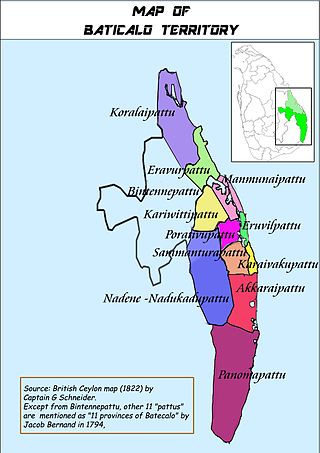Related Research Articles

Batticaloa is a major city in the Eastern Province, Sri Lanka, and its former capital. It is the administrative capital of the Batticaloa District. The city is the seat of the Eastern University of Sri Lanka and is a major commercial centre. It is on the east coast, 111 kilometres (69 mi) south of Trincomalee, and is situated on an island. Pasikudah is a popular tourist destination situated 35 km (22 mi) northwest with beaches and flat year-round warm-water shallow-lagoons.
The caste systems in Sri Lanka are social stratification systems found among the ethnic groups of the island since ancient times. The models are similar to those found in Continental India, but are less extensive and important for various reasons, although the caste systems still play an important and at least symbolic role in religion and politics. Sri Lanka is often considered to be a casteless or caste-blind society by Indians.

The Jaffna Kingdom, also known as Kingdom of Aryachakravarti, was a historical kingdom of what today is northern Sri Lanka. It came into existence around the town of Jaffna on the Jaffna peninsula and was traditionally thought to have been established after the invasion of Kalinga Magha from Kalinga in India. Established as a powerful force in the north, northeast and west of the island, it eventually became a tribute-paying feudatory of the Pandyan Empire in modern South India in 1258, gaining independence when the last Pandyan ruler of Madurai was defeated and expelled in 1323 by Malik Kafur, the army general of the Delhi Sultanate. For a brief period in the early to mid-14th century it was an ascendant power in the island of Sri Lanka, to which all regional kingdoms accepted subordination. However, the kingdom was overpowered by the rival Kotte Kingdom around 1450 when it was invaded by Prince Sapumal under the orders of Parakramabahu VI.

Sri Lankan Tamils, also known as Ceylon Tamils or Eelam Tamils, are Tamils native to the South Asian island state of Sri Lanka. Today, they constitute a majority in the Northern Province, form the plurality in the Eastern Province and are in the minority throughout the rest of the country. 70% of Sri Lankan Tamils in Sri Lanka live in the Northern and Eastern provinces.
Sri Lankan Mukkuvar is a Tamil speaking ethnic group found in the Western and Eastern coastal regions of Sri Lanka. They are primarily concentrated in the districts of Batticaloa, Ampara and Puttalam. They are also related to "Sri Lankan Moors". Sri Lankan Mukkuvars along with Eastern Muslims of Sri Lankan claim their origin from Kerala and matrilineal in practice. Recent studies show their habits and clan structure, as well as dialects, show affinity towards the Northern Kerala regions.

Munneswaram temple is an important regional Hindu temple complex in Sri Lanka. It has been in existence at least since 1000 CE although myths surrounding the temple associate it with the popular Indian epic Ramayana, and its legendary hero-king Rama. The temple is one of the ancient Pancha Ishwarams dedicated to Shiva in the region.
History of Eastern Tamils of Sri Lanka is informed by local legends, native literature and other colonial documents. Sri Lankan Tamils are subdivided based on their cultural, dialects & other practices as into Northern, Eastern and Western groups. Eastern Tamils inhabit a region that is divided into Trincomalee District, Batticalo District and Ampara District.
Vanniar or Vanniyar was a title borne by chiefs in medieval Sri Lanka who ruled in the Chiefdom of Vavuni regions as tribute payers to the Jaffna vassal state. There are a number of origin theories for the feudal chiefs, coming from an indigenous formation. The most famous of the Vavni chieftains was Pandara Vannian, known for his resistance against the British colonial power.

The Vanni chieftaincies or Vanni principalities was a region between Anuradhapura and Jaffna, but also extending to along the eastern coast to Panama and Yala, during the Transitional and Kandyan periods of Sri Lanka. The heavily forested land was a collection of chieftaincies of principalities that were a collective buffer zone between the Jaffna Kingdom, in the north of Sri Lanka, and the Sinhalese kingdoms in the south. Traditionally the forest regions were ruled by Vedda rulers. Later on, the emergence of these chieftaincies was a direct result of the breakdown of central authority and the collapse of the Kingdom of Polonnaruwa in the 13th century, as well as the establishment of the Jaffna Kingdom in the Jaffna Peninsula. Control of this area was taken over by dispossessed Sinhalese nobles and chiefs of the South Indian military of Māgha of Kalinga (1215–1236), whose 1215 invasion of Polonnaruwa led to the kingdom's downfall. Sinhalese chieftaincies would lay on the northern border of the Sinhalese kingdom while the Tamil chieftaincies would border the Jaffna Kingdom and the remoter areas of the eastern coast, north western coast outside of the control of either kingdom.
Social class in Sri Lanka is often described as casteless, though caste is still found on the island in both a symbolic and a practical sense. Caste is also used in an analogous sense to refer to the new social class divisions that have appeared in recent decades. The combination of ethnic nationalist movements that saw caste as an island-wide dividing tool, strong emphasis on providing access to education and healthcare regardless of background, and historic lack of discrimination among the colonial civil service played a factor in eradicating the caste system in most sectors of the island's society. Although the Buddhist culture actively fought against all forms of class discrimination, many Buddhist organizations used caste as a method to extract surplus from temple property.
Chilaw is a city in Puttalam District, North Western Province, Sri Lanka. It is governed by an urban council, whereas the outskirts are governed by a pradeshiya sabha of the same name. The town is located 80 kilometres away from Colombo via Negombo.

Mannar District is one of the 25 districts of Sri Lanka, the second level administrative division of the country. The district is administered by a District Secretariat headed by a District Secretary appointed by the central government of Sri Lanka. The capital of the district is Mannar, which is located on Mannar Island.
Maradankulama or Maradankulam is a village situated within the North Western Province of Sri Lanka. It is one of the oldest settlements within the geographic region that formed the medieval divisions of the country called Demala Pattuva. Most villagers speak Sinhala language but unlike the majority of Sinhala language speakers who are Buddhists, they are Saivite Hindus like the minority Sri Lankan Tamils. The village hosts an important festival dedicated to Ayyanar who is a popular village guardian deity. The village along with another predominantly Hindu village Udappu also sponsors a day in the annual chariot festival of the Munneswaram temple situated nearby.

Ati Konanayakar or Aathi Koneswaram is a regionally important Hindu temple in Tampalakamam village in the Trincomalee District of Sri Lanka. The name of the temple in Tamil means the "temple of the original lord of Koneswaram". It is situated 24 kilometers (15 mi) from the port town of Trincomalee. The temple was constructed during the 17th century as a successor to the Koneswaram temple that was destroyed by Portuguese colonials in 1622.

Kataragama temple in Kataragama, Sri Lanka, is a temple complex dedicated to Buddhist guardian deity Kataragama deviyo and Hindu War God Murugan. It is one of the few religious sites in Sri Lanka that is venerated by the Buddhists, Hindus, Muslims and the Vedda people. For most of the past millennia, it was a jungle shrine very difficult to access; today it is accessible by an all-weather road. The shrines and the nearby Kiri Vehera are managed by Buddhists, the shrines dedicated to Teyvāṉai and Shiva are managed by Hindus and the mosque by Muslims.
Native headmen system was an integral part of the administration of the island of Ceylon under the successive European colonial powers, namely the Portuguese Empire, the Dutch East India Company and the British Empire. Native headmen or leaders were appointed by the European colonial administrators to function as intermediates between the Europeans and the native populous. During different periods through this system these headmen functioned in military, policing, administrative and ceremonial capacities. They served as translators, revenue collectors and wielded quasi-judicial powers. Much of the system evolved and changed over time until some of the last vestiges of it were removed in the post-independent Ceylon.
The Pancha Ishwarams are five coastal ancient kovils (temples) built in dedication to the Hindu supreme being Ishwara in the form of the god Shiva, located along the circumference of Sri Lanka.

Thirukkovil Temple is the most significant Hindu temple in Thirukkovil, Ampara District of Eastern Province, Sri Lanka. It is dedicated to Chitravelayudhar who was once the guardian deity of Mattakkalappu Desam and this temple enjoyed the honor of Desathukkovil of the Batticaloa region. Archaeological and historical evidences suggest that Cholan, Kotte and Kandyan kings maintained strong relations with this temple in the past.

Batticaloa region in colonial records was the ancient region of Tamil settlements in Sri Lanka. The foremost record of this region can be seen in Portuguese and Dutch historical documents along with local inscriptions such as Sammanthurai Copper epigraphs written in 1683 CE which also mentions Mattakkalappu Desam. Although the region was bifuricated into districts of Batticaloa and Ampara Districts, the amended term "Batti-Ampara Districts" as well as “Keezhakarai” can still be seen in the Tamil print media of Sri Lanka.
The Pathans of Sri Lanka were a Muslim community in Sri Lanka of Pashtun ancestry. Most of them left in the 20th century, however a small number of families living in the country still claim Pathan ancestry.
References
- Bastin, Rohan (December 2002). The Domain of Constant Excess: Plural Worship at the Munnesvaram Temples in Sri Lanka. Berghahn Books. ISBN 1-57181-252-0.
- Chitty, Simon Casie (1834). The Ceylon gazetteer: containing an account of the districts of Ceylon. Gotta Church Mission. ISBN 1-57181-252-0.